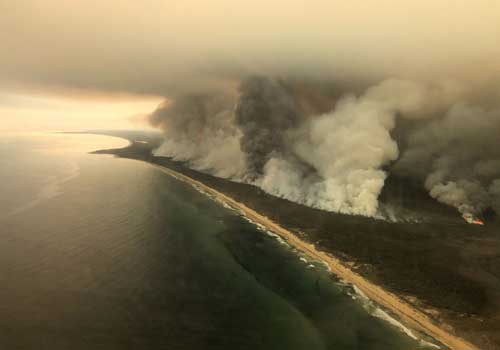Home » Climate Crisis Resource Hub » Understanding the climate crisis
Understanding the climate crisis
“We are the first generation to feel the effect of climate change and the last generation who can do something about it.”
Barack Obama, Former US President

An existential threat to civilisation
With the present level of warming – 1.1°C higher than the late-nineteenth century – the Earth is already too hot and unsafe: we are in danger now, not just in the future. Catastrophic heatwaves and bushfires, droughts and crop failures, and cyclones and coastal flooding are reaching around the globe.
The Great Barrier Reef and other coral systems are dying, and the world is now facing the sixth mass extinction in history. The world’s insects are hurtling down a path to extinction, threatening a “catastrophic collapse of nature’s ecosystems”, according to a recent global scientific review which found that the total mass of insects is falling by a precipitous 2.5% a year.
As well, we are greatly exceeding Earth’s limits. The growth in physical resource use is unsustainable and will lead to resource and economic overshoot and collapse unless we change path.
Climate change is contributing to food and water shortages and declining crop yields. Rising food prices driven by drought, wildfire and harvest failures have already become catalysts for social breakdown and conflict across the Middle East, the Maghreb and the Sahel. Climate change has become an accelerant to social instability.
(From the Breakthrough Guide ‘Climate Emergency Explored’, 2020, by David Spratt).
The Critical Decade
These unprecedented climate events have led to a growing consciousness in the Australian and global population that climate change is happening now and that we are in a climate crisis.
Scientists warn we have between 10 to 12 years to turn things around on climate change- to reduce emissions, globally, to levels that will limit temperature rise to 2 degrees above pre-industrial levels. Right now, we are on track to 3-4 degrees of warming by 2100. The unprecedented bushfires of 2019/20 have happened to a climate that’s been changed by just 1 degree of warming.
(From an article written by Anna Rose, Australian climate campaigner, Peppermint Magazine Issue 45, Autumn 2020).
By 2050 at the latest, and ideally by 2040, we must have stopped emitting more greenhouse gases into the atmosphere than Earth can naturally absorb through its ecosystems (a balance known as net-zero emissions or carbon neutrality). In order to get to this scientifically established goal, our global greenhouse gas emissions must be clearly on the decline by the early 2020s and reduced by at least 50% by 2030.
The goal of halving global emissions by 2030 represents the absolute minimum we must achieve if we are to have at least 50% chance of safeguarding humanity from the worst impacts. We are in the critical decade. It is no exaggeration to say that what we do to reduce emissions between now and 2030 will determine the quality of human life on our planet for hundreds of years to come, if not more.
(From the book ‘The Future We Choose’, 2020, by former UN Executive Secretary for Climate Change, Christiana Figueres, and Tom Rivett-Carnac, a senior political strategist for the Paris Agreement).
COVID-19
Even though our lives have been impacted by the COVID-19 pandemic, Australian and global citizens have not forgotten the climate crisis and in fact the majority agree that climate action should be prioritised in our governments’ economic stimulus plans. In April 2020 an Ipsos survey found that two thirds of citizens around the world agree climate change is as serious a crisis as COVID-19. Furthermore, this poll of the 28,000 people in 14 countries found widespread support for government actions to prioritise climate change in the economic recovery after COVID-19, with 65% globally agreeing this is important. For Australia, 57% agreed climate change should be prioritised in the economic recovery actions.
Read more
Educating your community
Find out more
Building your personal resilience
Find out more
